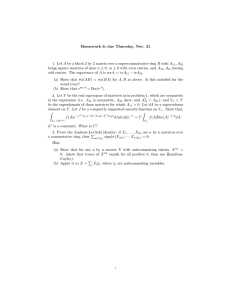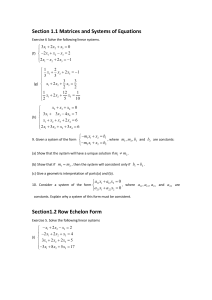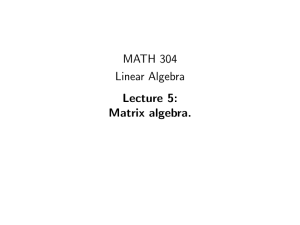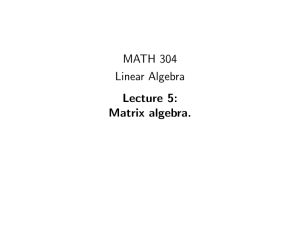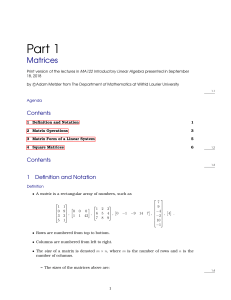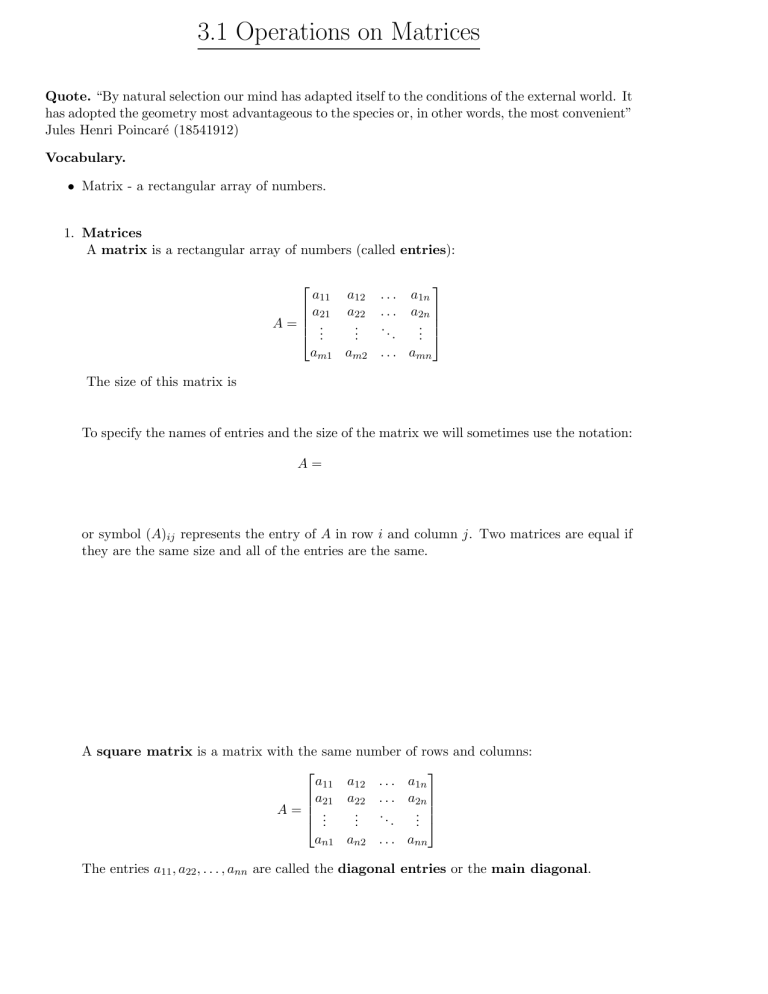
3.1 Operations on Matrices
Quote. “By natural selection our mind has adapted itself to the conditions of the external world. It
has adopted the geometry most advantageous to the species or, in other words, the most convenient”
Jules Henri Poincaré (18541912)
Vocabulary.
• Matrix - a rectangular array of numbers.
1. Matrices
A matrix is a rectangular array of numbers (called entries):
!
a11
" a21
"
A=" .
# ..
a12
a22
..
.
...
...
..
.
$
a1n
a2n %
%
.. %
. &
am1 am2 . . . amn
The size of this matrix is
To specify the names of entries and the size of the matrix we will sometimes use the notation:
A=
or symbol (A)ij represents the entry of A in row i and column j. Two matrices are equal if
they are the same size and all of the entries are the same.
A square matrix is a matrix with the same number of rows and columns:
!
$
a11 a12 . . . a1n
" a21 a22 . . . a2n %
"
%
A=" .
..
.. %
.
.
.
# .
.
.
. &
an1 an2 . . . ann
The entries a11 , a22 , . . . , ann are called the diagonal entries or the main diagonal.
2. Diagonal Matrices
A square matrix in which all entries off the main diagonal are zero is called a diagonal
matrix.
!
$
d1 0 0
Example: D = # 0 d2 0 &
0 0 d3
3. Triangular matrices
• A square matrix in which all entries above the main diagonal are zero is called lower
triangular (LT), and a square matrix in which all the entries below the main diagonal
are zero is called upper triangular (UT).
• A matrix that is either upper triangular or lower triangular is called triangular (T).
Example: Which one of the following matrices
!
$
a11 a12 a13 a14
" 0 a22 a23 a24 %
"
%
# 0
0 a33 a34 &
0
0
0 a44
is upper/lower triangular?
!
$
a11 0
0
0
"a21 a22 0
0 %
"
%
#a31 a32 a33 0 &
a41 a42 a43 a44
Example: How can we express these properties algebraically?
• A is UT if aij =
, for every
.
• A is LT if aij =
, for every
.
Example: Can a matrix be both lower and upper triangular?
4. Equality of matrices: Two matrices A and B are equal if they have the same size and
their corresponding entries are equal,
that is, if A = [aij ]m×n and B = [bij ]r×s then
A = B ⇐⇒
5. Addition, subtraction and scalar multiplication of matrices. Addition, subtraction
and scalar multiplication:
If matrices A and B have the same size and c is a scalar then
(A + B)ij = (A)ij + (B)ij
(A − B)ij = (A)ij − (B)ij
(cA)ij = c(A)ij
If they do not have the same size A + B and A − B are undefined.
Example. Given matrices
!
$
!
$
'
(
'
(
2 0
6 3
4
−3
0
1
2
3
A = #7 −5& , B =
,C =
, D = #4 5&
1 5 −1
0 −1 0
4 3
9 8
Evaluate A + B, A + D, B − D, C − B, 5A and (−2)B
6. List of row and column vectors
Any matrix can be thought of as
(a) a list (row) of columns vectors; or
(b) a list (column) of row vectors.
In general, if A = [aij ]m×n , we can write
!
$
r1 (A)
%
)
* "
" r2 (A) %
A = c1 (A) c2 (A) . . . cn (A) = " . %
# .. &
rm (A)
where ri (A) is the i-th row of A and cj (A) is the j-th column of A.
!
$
3 0 7 5
Example. What are the column and row vectors of A = #2 9 6 0&
1 8 1 4
7. Span and linear independence for Matrices
These follow directly from the same definitions we had for vectors.
Let B = {A1 , ...., Ak } be a set of matrices.
The span of B is defined as Span B = {t1 A1 + .... + tk Ak }
The set B is linearly independent if the only solution to c1 A1 + .... + ck Ak = 0
is c1 = ... = ck = 0.
8. Example
+'
( '
( '
(,
1 2
0 1
1 1
Let B =
,
,
1 0
−1 2
3 −1
'
(
2 3
and determine if the set is linearly independent. Is
in the Span B?
2 −3
9. Transpose
If A is an m × n matrix, then the transpose of A, denoted as AT , is the n × m matrix
created by making the rows of A into columns. We can write this as (AT )ij = (A)ji .
'
(
)
*
−3 2 1
Example. Suppose A =
and B = 8 7 1 . Find AT , B T and (B T )T .
0 2 4
10. Matrix vector multiplication
Example. Consider the following linear system
3x1 −7x2 + x3 =4
5x1 + x2 +2x3 =2
We can naturally associate three matrices with the system:
! $
'
(
' (
#
&
A=
, x=
, and b =
A is usually called the coefficient matrix of the system.
We want to define the product Ax in such a way that the m = 2 linear equations can be
rewritten in a single matrix equation Ax = b.
Note that m = 2 linear equations can be written as a single matrix equation as follows:
The product Ax (definition):
Suppose A is an m × n matrix and x is an n × 1 column vector. The product Ax is defined
as:
!
$! $ !
$
a11 a12 . . . a1n
x1
a11 x1 + a12 x2 + · · · + a1n xn
" a21 a22 . . . a2n % " x2 % " a21 x1 + a22 x2 + · · · + a2n xn %
"
%" % "
%
Ax = " .
%
..
.. % " .. % = "
..
..
# ..
&
#
&
#
&
.
.
.
.
.
am1 am2 . . . amn
xn
am1 x1 + am2 x2 + · · · + amn xn
Remark: The result of multiplication is m × 1 column vector. The product is only defined
when the number of columns of A is the same as the number of rows of x.
Example:
We can also view the product Ax as a linear combination of column vectors of A:
!
"
"
Ax = "
#
a11 x1 + a12 x2 + · · · + a1n xn
a21 x1 + a22 x2 + · · · + a2n xn
..
.
am1 x1 + am2 x2 + · · · + amn xn
$
%
%
% = x1 c1 (A) + x2 c2 (A) + · · · + xn cn (A)
&
Or we can view the product Ax as a column vector composed of dot products of row vectors
of A and x:
!
$
$
r1 (A) · x
"
% "
"
% " r2 (A) · x %
%
Ax = "
%=#
... &
#
&
rm (A) · x
am1 x1 + am2 x2 + · · · + amn xn
a11 x1 + a12 x2 + · · · + a1n xn
a21 x1 + a22 x2 + · · · + a2n xn
..
.
!
Example. Evaluate the following using all three methods:
! $
'
( 3
5 0 2 # &
−2
−1 4 1
10
11. The product AB
Suppose A is an m × n matrix and B is an n × p matrix. The product AB is the m × p
matrix defined as
)
*
Ac1 (B) Ac2 (B) . . . Acp (B)
$
1 10 −2 0
4 0 5
1 5&, find AB and BA.
Example. Given A =
and B = #0 6
3 −2 8
2 2 −7 9
'
(
!
12. Linearity properties If A is an m × n matrix, u and v are vectors in Rn , and c is a scalar,
then
(a) A(cu) = c(Au)
(b) A(u + v) = Au + Av
13. IMPORTANT properties of matrix mutliplication
• Matrix multiplication is NOT commutative.
• The cancellation law is NOT valid.
• AB = 0 does not mean that one of A or B is zero.
14. The Identity Matrix


